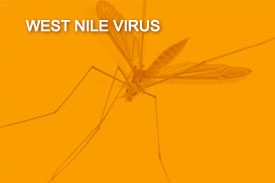Home
»
News
»
Narratives of One Health In Action
West Nile Virus
11/21/2011
Human and animal science converges in defeating zoonotic diseases
 West Nile virus causes an emerging infectious disease that was first discovered in Uganda in 1937. In recent years it has spread beyond its traditional boundaries, causing illness in birds, horses, and humans in Europe and the United States. Since its discovery in New York in 1999, West Nile virus has been detected in humans, animals, and mosquitoes throughout the United States.
West Nile virus causes an emerging infectious disease that was first discovered in Uganda in 1937. In recent years it has spread beyond its traditional boundaries, causing illness in birds, horses, and humans in Europe and the United States. Since its discovery in New York in 1999, West Nile virus has been detected in humans, animals, and mosquitoes throughout the United States.
In 1999 in New York City, several elderly people became deathly ill with signs of encephalitis, and crows began dying in large numbers in the same area. Analyses of human blood specimens by the Centers for Disease Control and Prevention (CDC) initially suggested St. Louis encephalitis (SLE), a disease that had previously occurred in the area and is transmitted from infected birds to humans by mosquitoes. But something didn’t seem right since birds do not normally show any signs of illness from SLE. Dr. Tracey McNamara, head pathologist at the Bronx Zoo, began to investigate why a growing number of crows were becoming ill and dying. An epidemiologist at the city health department raised concern that the large numbers of dead birds might be connected to the human cases of encephalitis. McNamara soon was dealing with the deaths of a cormorant, several flamingos, and a bald eagle.
Analysis of samples from the dead zoo birds by the US Department of Agriculture National Veterinary Services Lab in Ames, Iowa, revealed a virus too small to be SLE virus. It was soon clear that the human and bird deaths were being caused by the same virus and that this was a newly emerging disease. Nearly 3 months after the initial outbreak, government scientists announced that the disease was caused by West Nile virus, which had never before been found in the Western hemisphere.
The 1999 epidemic in the New York City area resulted in 62 cases of encephalitis and 7 deaths. Zoo birds, American crows and at least 20 other North American wild bird species and horses were also affected. It is not clear how West Nile virus entered the United States. It could have come from a mosquito carried on a plane, or it may have been from an infected wild or imported bird. But since its introduction, West Nile virus has continued to spread and is now a significant threat to the health of humans, birds, and horses. Since 1999, there have been 1.5 million West Nile virus infections in the United States.





 West Nile virus causes an emerging infectious disease that was first discovered in Uganda in 1937. In recent years it has spread beyond its traditional boundaries, causing illness in birds, horses, and humans in Europe and the United States. Since its discovery in New York in 1999, West Nile virus has been detected in humans, animals, and mosquitoes throughout the United States.
West Nile virus causes an emerging infectious disease that was first discovered in Uganda in 1937. In recent years it has spread beyond its traditional boundaries, causing illness in birds, horses, and humans in Europe and the United States. Since its discovery in New York in 1999, West Nile virus has been detected in humans, animals, and mosquitoes throughout the United States.